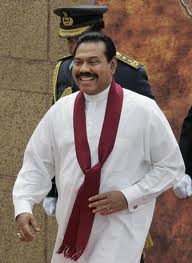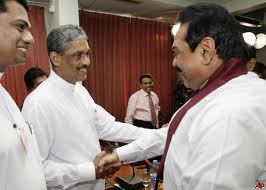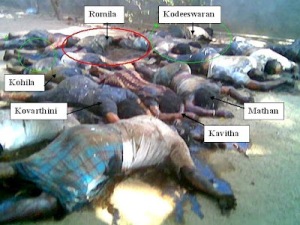 In some part of the North, the soil is actually red. You could mistake it for a Martian ground. But the real sense of estrangement comes from politics.
In some part of the North, the soil is actually red. You could mistake it for a Martian ground. But the real sense of estrangement comes from politics.
The history of Sri Lanka and the surrounding region, is a complex one. Major interests orbit in the Indian Ocean; China and India are testing each other; India is still a work in progress as a conglomerate of ethnicities, powers, traditions. The elimination of the LTTE was a move that found too many, too powerful supporters. But the problem resides in the way it has been achieved: a military conquest with a barbaric massacre of civilian population and. We have two clear issues in the aftermath of the IV Eelam War.
The first is that war crimes have been committed. Atrocities were common during the civil war, many done by the LTTE as well. This is by no means an excuse to condone what happened in the Vanni in 2009. The Mullivaikal shores are the emblem of such carnage.

President Rajapaksa unveiled a monument in Pudumathalan, not far from the shores of Mullivaikail, where the last massacres took place.
Courtesy to Sudath Silva
The second is that the military operation was conducted against the LTTE, but the Tamil aspirations haven’t been addressed. Actually it looks like that the ‘Sinhalese State conquered the North’ and its aim was to subjugate any form of alternative to the majoritarian culture.
Anybody who is dealing with the situation in Sri Lanka knows very well that the army is an oppressive presence; that Tamils are struggling to have the same rights of the Sinhalese, not more, as in the case of the provincial councils . The government wanted to punish the Tamils to reassert a dominion, not be questioned anymore.
Then it comes the circus of media mainstream. On July the 26th, the government issued a plan to implement the recommendations of the LLRC, the Lessons Learnt and Reconciliation Commission. It is a government appointed commission that should inquiry about any measure to be taken to prevent the occurrence of another conflict. In other words it’s a judgement about what happened and what should be done to prevent another ethnic conflict. The reason for the conflict are quite simple: the Tamil minority has been oppressed and cornered to such an extent that its reaction went out of control, in the form of the armed struggle of the LTTE. The IV Eelam War saw the total annihilation of the LTTE and also the complete subjugation of the Tamil civilian population. President Rajapaksa is the architecture of this final, extreme solution. So you shouldn’t expect that a commission appointed by him could achieve too much.

President Mahinda Rajapaksa
courtesy Commonwealth Secretariat
But the farce it has only begun. We are discussing the reasons of the conflict on the merit of an inquiry promoted by the very perpetrator of the final massacre. But now the subject is precisely this: we are discussing the LLRC. And supreme irony, the government struggles to implement even the farce it has established.
The commission has no power of investigating correctly what happened and even less the will to go to the roots of the discrimination and the oppression. But just talking about that, just mentioning the facts is too embarrassing for the government. And it should be. Only in Sri Lanka you can really debate about those facts: they did happen, everybody knows (everybody, including the USA, Europe and the UN), and yet we are arguing about the LLRC.

Buddhist monks, supporters of the government, march towards the U.S. Embassy, to urge the United States to withdraw its support for a proposed U.N. Human Rights Council resolution on alleged abuses during the country’s civil war, in Colombo, Sri Lanka, Wednesday, March 14, 2012.
In March 2012, the UN commission for the human rights approved a resolution ‘against’ Sri Lanka. Much of the Tamil community was ecstatic for this victory, especially because India sided against Colombo. The crude reality of facts is that New Delhi fooled the Tamils, because the vote was powerless. You can celebrate the mere happening of such a friction between Sri Lanka and India, yet if you are waiting for concrete intervention, don’t hold your breath. But the votation actually stated that Sri Lanka should at least implement its own recommendations.
On the 26th of July president Rajapaksa decided to issue the new action line for the implementation of the LLRC, dismissing that it did because of international pressure, you don’t know if it’s time to smile or to cry.
 It seems really a parody to discuss the Tamil issue and the situation in the Northern Provinces on the bases of the LLRC. Let’s start with demilitarization. Civilian officers are replacing military ones. “95%”, or so they say. And we are discussing these figures? If you ask the people in the Northern Provinces, they’ll tell you a different story. You need to ask the permission of a army commander to do everything.They are militarizing the mind. Between 60% and 75% of the Sri Lankan army is stationed in the North.
It seems really a parody to discuss the Tamil issue and the situation in the Northern Provinces on the bases of the LLRC. Let’s start with demilitarization. Civilian officers are replacing military ones. “95%”, or so they say. And we are discussing these figures? If you ask the people in the Northern Provinces, they’ll tell you a different story. You need to ask the permission of a army commander to do everything.They are militarizing the mind. Between 60% and 75% of the Sri Lankan army is stationed in the North.
Constant abuse, from intimidation to rapes are normal stories in the day to day life of the Tamil. Most recently, the problem of land grabbing from the army. It is a growing phenomenon that attract some attention. The army is confiscating land from the Tamils. These are just few examples, but the message is that the government has no intention to take seriously the Tamil issue. You don’t need to be an extremist to see that this is simply preparing the ground for a growing tension. Far from reconciliation and unity, it’s just another chapter in the oppression of the Tamils. The LTTE took a wrong path, but you can easily see why it all started. Yet, the LLRC is telling you another story. And bear in mind, they can’t even implement that.

courtesy Daily FT
 The focus on LLRC is a diplomatic mirror to elude the reality of fact: the US, Europe and India can confront Sri Lanka on that irrelevant field. Sri Lanka will respond, UN will make more pressure, finally they will find a compromise. Everybody is happy, the West shows it has forgot Sri Lanka, India can say that they fight for the Tamils on the international stage and Colombo can cry on this fake diplomatic defeat.
The focus on LLRC is a diplomatic mirror to elude the reality of fact: the US, Europe and India can confront Sri Lanka on that irrelevant field. Sri Lanka will respond, UN will make more pressure, finally they will find a compromise. Everybody is happy, the West shows it has forgot Sri Lanka, India can say that they fight for the Tamils on the international stage and Colombo can cry on this fake diplomatic defeat.














